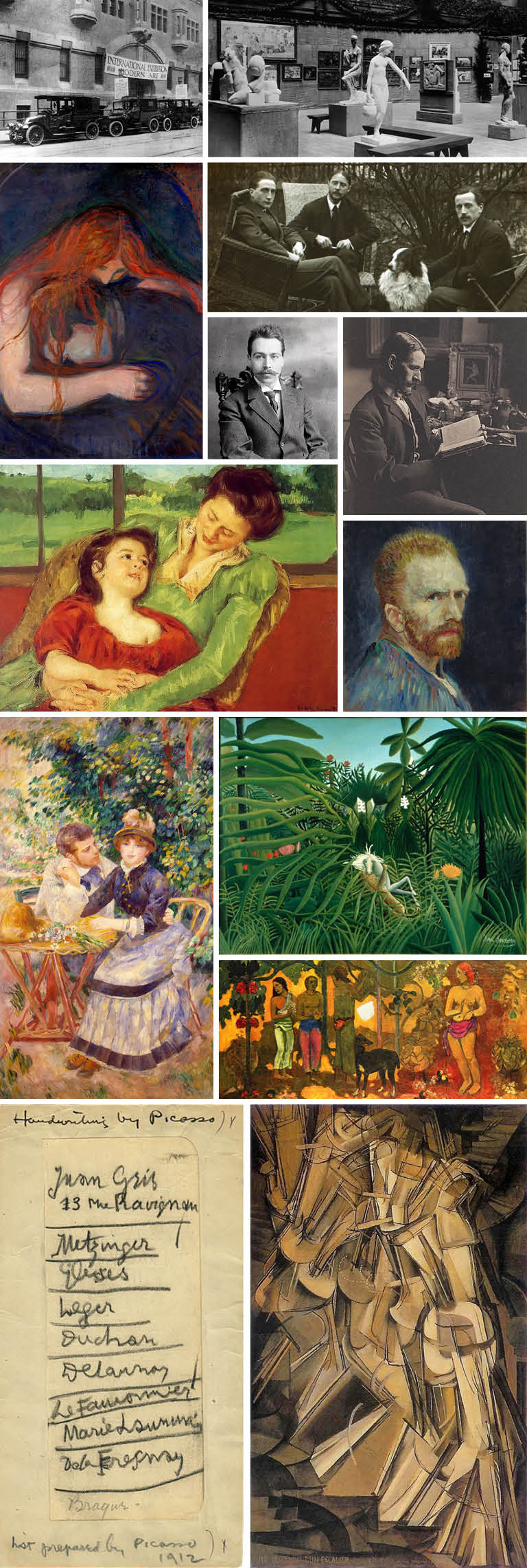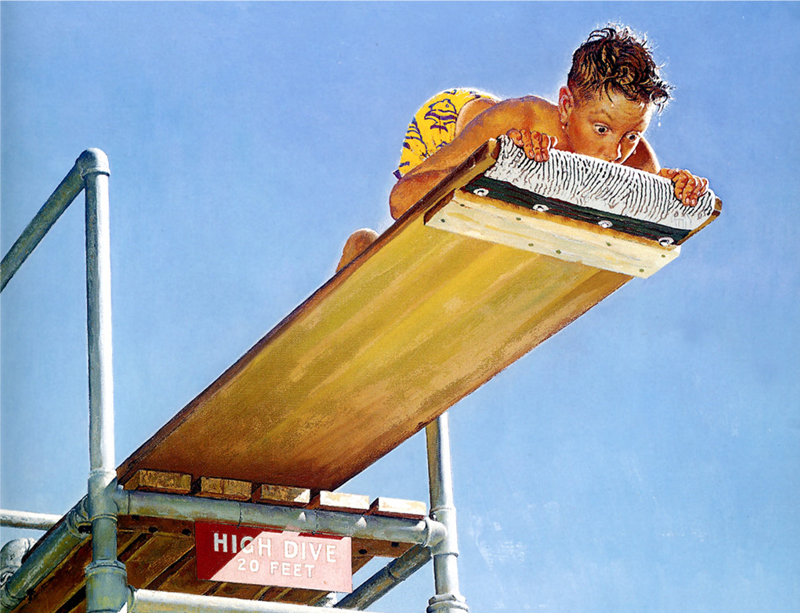
(top row left) Entrance of the Exhibition, 1913, New York City; (top row right) Interior view of the exhibition; (second row left) Edvard Munch-Vampire (1895); (second row right top) Marcel Duchamp, Jacques Villon, Raymond Duchamp-Villon, and Villon’s dog Pipe in the garden of Villon’s studio, Puteaux, France, ca. 1913. All three brothers were included in the exhibition. (second row center) Walter_Pach,_circa_1909; (second row right bottom) Arthur B. Davies, circa 1908; (third row left) Mary Cassatt, Mère et enfant (Reine Lefebre and Margot before a Window), c.1902; (third row right) Vincent van Gogh, Self-Portrait, c. 1887; (fourth row left) Pierre-Auguste Renoir, In The Garden 1885; (fourth row right top) Henri Rousseau, Jaguar Attacking a Horse, 1910; (fourth row right bottom) Paul Gauguin, Tahitian Pastorals, 1898; (fifth row left) A list written in 1912 by Pablo Picasso of European artists he felt should be included in the 1913 Armory Show. This document dispels the assertion that an unbridgeable divide separated the Salon Cubists from the Gallery Cubists. (fifth row right) Marcel Duchamp, Nude Descending a Staircase, No. 2, 1912.
Throughout history, and throughout our companies, we often experience events that are real game changers. For us, it can be small things, like a certain person we hire who changes our perspectives, an investment in a new piece equipment that creates a new market opportunity, a treatment approach that solves a dilemma, or a customer who challenges us with a “real” PIA (pain in the @#$) Job!. Once the event takes place and the challenge overcome, things are just never the same. Sometimes we sit around and often laugh, reflecting back, telling “remember when” stories (think of your first cell phone). So many good, unexpected things that have happened over the years combine to make us what we are today. And the coolest part is, it’s sort of instilled a real positive, “give it a try” attitude with my team.
For me as chief bottle washer, I love it when my staff comes in and shows me how they solved a problem, or tried a new approach, and it works. We like to take time and celebrate the milestones, share the ideas, and best of all, tell you, our customers.
- This past weekend, I had the pleasure of going to the Cleveland Museum of Art – just a “day out” with my favorite “pal” – we had a blast. Inspired, I decided to write about another “event” which took place, that changed the American art world forever. Known as the NY Armory Show, a group of over 100 artists came together to share their work with the world. As often happens with “new” art, onlookers were amazed and shocked. President Teddy Roosevelt, threatening to shut down the show, decried “That’s Not Art”, joined by unhappy critics, writers and historians. Outrage was the common response. Delight was the feelings of the artists, who came together to share their new ideas, techniques and approaches. Thanks to Wikipedia, here are just some of the highlights:
- On December, 14 1911 an early meeting of what would become the Association of American Painters and Sculptors (AAPS) was organized at Madison Gallery in New York. Four artists met to discuss the contemporary art scene in the United States, and the possibilities of organizing exhibitions of progressive artworks by living American and foreign artists, favoring works ignored or rejected by current exhibitions.
- The AAPS members spent more than a year planning their first project: the International Exhibition of Modern Art, a show of giant proportions, unlike any New York had seen. The 69th Regiment Armory was settled on as the main site, designed to “lead the public taste in art, rather than follow it, rented for a fee of $5,000, plus an additional $500 for additional personnel.
- Once the space had been secured, the most complicated planning task was selecting the art for the show, particularly after the decision was made to include a large proportion of vanguard European work, most of which had never been seen by an American audience.
- Together, the key organizers went to Europe, and secured three paintings that would end up being among the Armory Show’s most famous and polarizing: Matisse’s “Blue Nude (Souvenir de Biskra)” and “Madras Rouge (Red Madras Headdress),”and Duchamp’s “Nude Descending a Staircase, No. 2.”
- The Armory Show displayed some 1,300 paintings, sculptures, and decorative works by over 300 avant-garde European and American artists. Impressionist, Fauvist, and Cubist works were represented in 18 distinct gallery areas.
- News reports and reviews were filled with accusations of quackery, insanity, immorality, and anarchy, as well as parodies, caricatures, doggerels and mock exhibitions. About the modern works, former President Theodore Roosevelt declared, “That’s not art!”. The civil authorities did not, however, close down or otherwise interfere with the show.
Here is a partial list of the artists in the show – I highlighted some of my favorites. Just imagine these differing artists, styles and statements all in one show – WOW!
Robert Ingersoll Aitken, Alexander Archipenko, George Grey Barnard, Chester Beach, Gifford Beal, Maurice Becker, George Bellows, Joseph Bernard, Guy Pène du Bois, Oscar Bluemner, Pierre Bonnard, Solon Borglum, Antoine Bourdelle, Constantin Brâncuși, Georges Braque, Bessie Marsh Brewer, Patrick Henry Bruce, Paul Burlin, Theodore Earl Butler, Charles Camoin, Arthur Carles, Mary Cassatt, Oscar Cesare, Paul Cézanne, Robert Winthrop Chanler, Pierre Puvis de Chavannes, John Frederick Mowbray-Clarke, Nessa Cohen, Camille Corot, Kate Cory, Gustave Courbet, Henri-Edmond Cross, Leon Dabo, Andrew Dasburg, Honoré Daumier, Jo Davidson, Arthur B. Davies (President), Stuart Davis, Edgar Degas, Eugène Delacroix, Robert Delaunay, Maurice Denis, André Derain, Katherine Sophie Dreier, Marcel Duchamp, Georges Dufrénoy, Raoul Dufy, Jacob Epstein, Mary Foote, Roger de La Fresnaye, Othon Friesz, Paul Gauguin, William Glackens, Albert Gleizes, Vincent van Gogh, Francisco Goya, Marsden Hartley, Childe Hassam, Robert Henri, Edward Hopper, Ferdinand Hodler, Jean Auguste Dominique Ingres, James Dickson Innes, Augustus John, Gwen John, Wassily Kandinsky, Ernst Ludwig Kirchner, Leon Kroll, Walt Kuhn (Founder), Gaston Lachaise, Marie Laurencin, Ernest Lawson, Henri de Toulouse-Lautrec, Arthur Lee, Fernand Léger, Wilhelm Lehmbruck, Jonas Lie, George Luks, Aristide Maillol, Édouard Manet, Henri Manguin, Edward Middleton Manigault, John Marin, Albert Marquet, Henri Matisse, Alfred Henry Maurer, Kenneth Hayes Miller, David Milne, Claude Monet, Adolphe Monticelli, Edvard Munch, Ethel Myers, Jerome Myers (Founder), Elie Nadelman, Olga Oppenheimer, Walter Pach, Jules Pascin, Francis Picabia, Pablo Picasso, Camille Pissarro, Maurice Prendergast, Odilon Redon, Pierre-Auguste Renoir, Boardman Robinson, Theodore Robinson, Auguste Rodin, Georges Rouault, Henri Rousseau, Morgan Russell, Albert Pinkham Ryder, André Dunoyer de Segonzac, Georges Seurat, Charles Sheeler, Walter Sickert, Paul Signac, Alfred Sisley, John Sloan, Amadeo de Souza Cardoso, Joseph Stella, Felix E. Tobeen, John Henry Twachtman, Félix Vallotton, Raymond Duchamp-Villon, Jacques Villon, Maurice de Vlaminck, Bessie Potter Vonnoh, Édouard Vuillard, Abraham Walkowitz, J. Alden Weir, James Abbott McNeill Whistler, Enid Yandell, Jack B. Yeats, Mahonri Young, Marguerite Zorach, William Zorach
For those of you in Cleveland looking to experience some great art this weekend, check out Brite Winter on Saturday. It’s a free art and music festival held in the Flats West Bank on Saturday, February 18th, 3PM–1AM.







